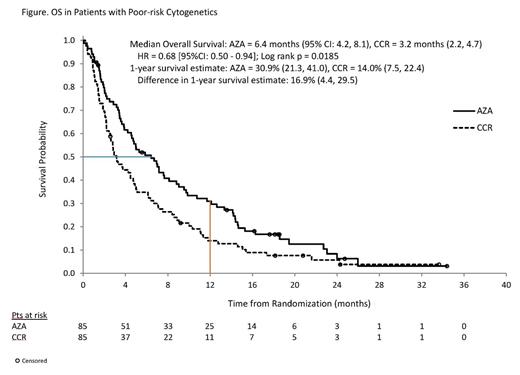Abstract
Background: Overall survival (OS) in older patients (pts) with AML and poor-risk cytogenetics is only ~2-3 months (mos) (Burnett, Cancer, 2007). Often these pts receive only palliative treatment (Tx) with best supportive care (BSC). Low-dose Ara-C (LDAC) provides no OS benefit in pts with poor cytogenetics (Döhner, Blood, 2010). Typically, intensive chemotherapy (IC) is either not suitable for older AML pts with poor cytogenetics or, when it is used, provides no OS benefit (Kantarjian, Blood, 2010). The phase 3, multicenter, randomized, open-label AZA-AML-001 trial showed azacitidine (AZA) Tx in older pts with newly diagnosed AML (>30% bone marrow [BM] blasts) prolonged median OS by ~4 mos vs conventional care regimens (CCR) (10.4 vs 6.5 mos; p=0.1009) and improved 1-year survival (46.5% vs 34.2%) (Dombret, EHA, 2014). Cytogenetic risk is a prognostic indicator in elderly AML and a frequent determinant of Tx approach and outcomes.
Objective: To determine the effect of Tx with AZA vs CCR on OS and 1-year survival in AZA-AML-001 pt subgroups based on cytogenetic risk classification.
Methods: Pts aged ≥65 years with newly diagnosed de novo or secondary AML who were ineligible for transplant, with intermediate- or poor-risk cytogenetics (pts with favorable cytogenetics were excluded from study), ECOG performance status 0-2, and WBC count ≤15x109/L, were eligible. Before randomization, each pt was preselected to receive 1 of 3 commonly used CCR for older pts with AML, per investigator choice: IC (standard 7+3 regimen), LDAC (20 mg SC BID x 10 days/28-day cycle), or BSC only. Pts were then randomized to AZA (75 mg/m2/day SC x 7 days/28-day cycle) or to CCR, in which case they received their preselected Tx. The primary endpoint was OS. Cytogenetic risk groups were assessed per NCCN criteria by central review: intermediate (INT; all cases), intermediate with normal karyotype (cytogenetic normal [CN]), and poor. Survival at 1 year was compared between Tx. Median OS for AZA vs CCR was calculated using Kaplan-Meier methods, hazard ratios (HR) and 95% confidence intervals (CI) were determined by unstratified Cox proportional hazards model, and p values by log-rank test.
Results: In all, 488 pts were randomized, 241 to AZA and 247 to CCR. Cytogenetic risk was balanced between Tx groups: 315 pts had INT-risk cytogenetics (AZA n=155 [64%], CCR n=160 [65%]), including 218 who were CN (AZA n=113 [73%], CCR n=105 [66%]), and 170 pts had poor-risk cytogenetics (AZA n=85 [35%], CCR n=85 [34%]). Within each of the 3 cytogenetic risk subgroups, the distribution of pts receiving individual CCR was very consistent: ~18% of each cytogenetic risk subgroup received BSC, ~64% received LDAC, and ~18% received IC. Baseline characteristics were generally balanced among the AZA and CCR Tx arms and the 3 cytogenetic risk groups (Table). At baseline, proportionately more pts with poor-risk cytogenetics in the AZA group were aged ≥75 years (57.6% vs 47.1% with CCR) and more pts in the CCR group had AML with myelodysplastic changes (45.9% vs 37.6% with AZA). Median OS (95%CI) in poor-risk pts was significantly prolonged with AZA vs CCR: 6.4 mos (4.2, 8.1) vs 3.2 mos (2.2, 4.7), respectively; HR=0.68 (0.50, 0.94), p=0.019 (Figure). Median OS in INT-risk pts was 13.0 mos (11.2, 16.3) vs 10.1 mos (7.1, 13.3) with AZA vs CCR; HR=0.90 (0.70, 1.16), p=0.41. Median OS in the CN subgroup was 14.1 mos (12.6, 19.5) vs 10.0 mos (6.4, 13.3); HR=0.81 (0.59, 1.10), p=0.18. Estimated 1-year survival was higher with AZA vs CCR in all cytogenetic risk subgroups. Twice the proportion of AZA-treated pts in the poor-risk subgroup were alive at 1 year vs. CCR pts (30.9% vs 14.0%, respectively), a clinically meaningful difference of 16.9% (95%CI 4.4, 29.5). Similarly, in the CN subgroup, 60.7% vs 44.1% of pts were alive at 1 year in the AZA and CCR groups, a difference of 16.5% (3.2, 29.8). AZA effect on 1-year survival in the INT-risk subgroup was also favorable (55.2% vs 45.5% with CCR) (difference 9.7% [-1.4, 20.8]). Grade 3-4 hematologic adverse event rates with AZA were consistent with previous reports (Santini, Eur J Haematol, 2010), with no meaningful differences among all cytogenetic risk groups.
Conclusions: Median OS in older pts with AML and poor-risk cytogenetics was meaningfully improved with AZA compared with the CCR currently used for AML, with those pts receiving AZA twice as likely to be alive at 1 year as those treated with CCR.
Döhner:Celgene: Consultancy. Off Label Use: Use of azacitidine in AML with blast count >30%. Seymour:Celgene: Consultancy, Honoraria, Speakers Bureau. Wierzbowska:Celgene: Honoraria, Speakers Bureau. Selleslag:Celgene: Consultancy, Research Funding, Speakers Bureau. Cavenagh:Celgene: Honoraria. Kumar:Celgene: Honoraria, Membership on an entity's Board of Directors or advisory committees. Schuh:Celgene: Membership on an entity's Board of Directors or advisory committees. Candoni:Celgene: Consultancy, Speakers Bureau. Récher:Celgene: Membership on an entity's Board of Directors or advisory committees, Research Funding. Sandhu:Celgene: Honoraria. Bernal del Castillo:Celgene: Consultancy. Al-Ali:Celgene: Honoraria, Research Funding. Martinelli:Novartis: Consultancy, Speakers Bureau; BMS: Consultancy, Speakers Bureau; Pfizer: Consultancy; ARIAD: Consultancy. Falantes:Celgene: Consultancy. Stone:Celgene: Consultancy, Membership on an entity's Board of Directors or advisory committees. Minden:Celgene: Honoraria. McIntyre:Celgene: Employment. Songer:Celgene: Employment, Equity Ownership. Lucy:Celgene: Employment, Equity Ownership. Beach:Celgene: Employment, Equity Ownership. Dombret:Celgene: Consultancy, Honoraria, Membership on an entity's Board of Directors or advisory committees.
Author notes
Asterisk with author names denotes non-ASH members.



This feature is available to Subscribers Only
Sign In or Create an Account Close Modal